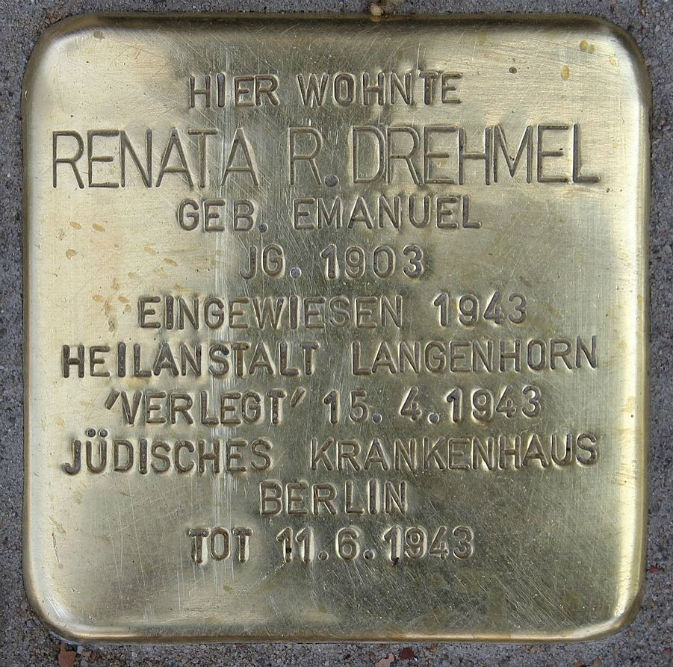Stumbling Stone Gärtnerstraße 117
This small, brass memorial plaque (Stolperstein or stumbling stone) commemorates:
* Renata R. Drehmel, née Emanuel, born 1903, admitted 1943 to Langenhorn Asylum, "relocated" 15 April 1943 to Jewish Hospital, Berlin, dead 11 June 1943.
Born in Hamburg, Renata Rahel Emanuel, called Rena, married a non-Jewish clerk, Fritz Drehmel, in 1928. Their only child, Werner Ivan Drehmel, was born the next year. When he was two, she began working as a sales assistant. Rena and Fritz started Werner in a Jewish school, then sent him to a public school, and finally back to the Jewish school.
The November 1938 Reichspogromnacht was deeply troubling. Then Rena lost her mother, her stepmother in 1939. In November 1941, her father was deported to Minsk.
In February 1942, Rena received the news that her sisters Frieda and Rosa had been arrested separately for "racial disgrace" [Rassenschande] and taken to the Lichtenburg and Fuhlsbüttel concentration camps. Both were murdered. 1942 became worse for Rena. Her husband died in April from a heart attack. Rena was so distraught that in August she tried to kill herself with sleeping pills. She was admitted to the Langenhorn Asylum for care. She was released, readmitted after another suicide attempt. This pattern continued. She was last released on 10 March 1943, only to find an official letter at home calling for the "resettlement" of herself and her son, who were to be taken to Theresienstadt on that very day. Her son Werner was deported on 12 March. Rena was re-admitted to Langenhorn and on 15 April was taken from there to Berlin’s Jewish Hospital where she died on 11 June. Cause of death is unknown. Five days after that, many patients were scheduled to be deported to Theresienstadt.
Werner Drehmel was kept in Theresienstadt until 6 October 1943, when he was deported to Auschwitz. He was 14. He survived – one of only 100 survivors among the 15,000 children who were deported out of Theresienstadt. He eventually emigrated to the US, attended Boston University, worked with autistic children, and was a family therapist for 30 years. He shared his story to children in a number schools in California.
The first stolperstein that was installed for Renata Drehmel at this address was vandalized and destroyed in early 2017. The vandals removed the whole concrete block. A second stolperstein was installed in July 2019 (photo above) near the location of the first, and sadly in September it, too, was destroyed – vandals ripped off the brass plate. See Bernd Carstensen’s photo of the destruction.
"Stolpersteine" is an art project for Europe by Gunter Demnig to commemorate victims of National Socialism (Nazism). Stolpersteine (stumbling stones) are small, 10x10cm brass plaques placed in the pavement in front of the last voluntary residence of (mostly Jewish) victims who were murdered by the Nazis. Each plaque is engraved with the victim’s name, date of birth, and place (mostly a concentration camp) and date of death. By doing this, Gunter Demnig gives an individual memorial to each victim. One stone, one name, one person. He cites the Talmud: "A human being is forgotten only when his or her name is forgotten."
Do you have more information about this location? Inform us!
Source
- Text: Fedor de Vries & Anne Palmer
- Photos: Hinnerk11
- Stolpersteineg: Renata Rahael Drehmel
- Obituary, Vern Drehmel
- Stolpersteine.eu
Nearby
Museum
- Museum Ernst Thälmann - Hamburg-Eppendorf
- School Museum Hamburg - Hamburg-St. Pauli
- Fuhlsbüttel Concentration Camp Hamburg - Hamburg-Ohlsdorf
Point of interest
- Former Synagogue Portuguese Community - Hamburg-Harvestehude
- Budgepalais Hamburg - Hamburg
- Remains Synagogue Poolstraße - Hamburg
Monument
- Memorial Jewish Retirement Home - Hamburg-Eimsbüttel
- Memorial Synagogue Hamburg - Hamburg
- Memorial Neue Dammtorsynagoge - Hamburg-Rotherbaum
Cemetery
- Mausoleum Konrad Daniel von Blücher-Altona - Hamburg-Altona-Altstadt
- Cemetery for Victims Siege of Hamburg - Hamburg-Altona
- German War Graves Hamburg-Altona - Hamburg
Remembrance Stone
- Stumbling Stones Mansteinstraße 49 - Hamburg-Hoheluft-West
- Stumbling Stone Gärtnerstrasse 107 - Hamburg-Hoheluft-West
- Stumbling Stone Gärtnerstraße 107 - Hamburg-Hoheluft-West





